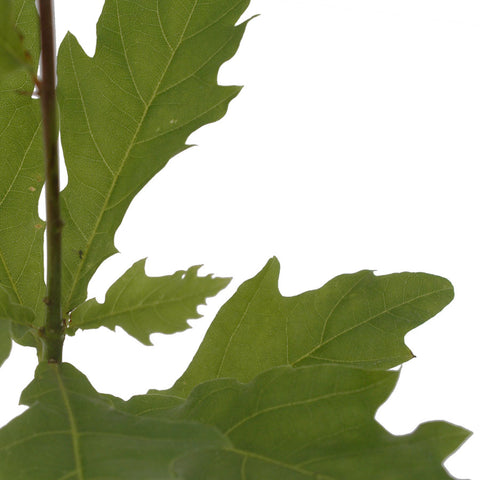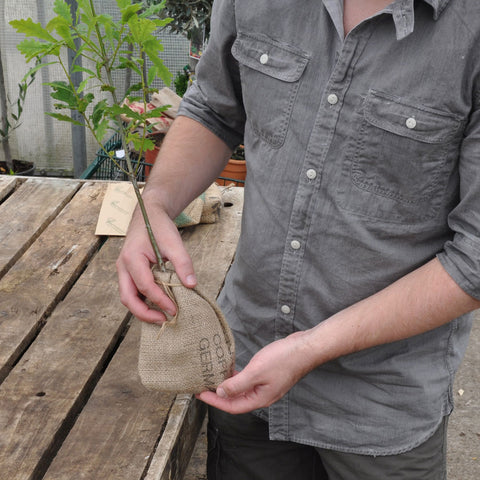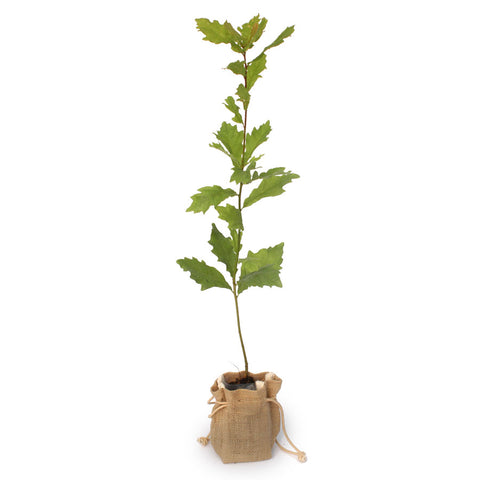Common Oak Tree Facts and Information
Quick Oak Tree Facts
- Latin name: Quercus robur
- Native words: Old Irish (duir), Scots Gaelic (darach), Old English (ac), Welsh (derwen), eastern Celtic (derva)
- Ogham sign: D
- Height when mature: 30–40m / 100 ft
- Height after 10 years:

Oak Tree Botanical Description
Types of Oak
There are two native British oak tree species:
- Common or Pedunculate Oak (Quercus robur)
- Sessile Oak (Quercus petraea)
Sessile oak was the first to arrive in the British Isles and grows naturally in upland areas; Quercus robur prefers lower regions.
Oak Tree Identification
Two key distinguishing features separate sessile and pedunculate oak: the acorn and the leaf stalk. Pedunculate acorns are on stalks ("peduncles"), sessile are not. Pedunculate oak has very short leaf stalks, visible even on dead leaves in winter.
In late winter and spring, light brown buds appear in spiral patterns on twigs, clustered at the tips. Leaves emerge between mid-April and mid-May.
Oak Leaves
Oak leaves have 3–6 uneven, thumb-shaped lobes per side, giving them a wavy edge. Insect galls may appear as small discs underneath the leaf, causing no serious harm. Leaves fall in October–November.
Oak Flowers
Oak flowers include male catkins (slender, pale green) and female flowers that grow on spiked stalks behind them. Male catkins appear with the first leaves.
Oak Fruits
Green acorns develop over summer in a small cup. They don't appear every year. Once fallen, the acorn sends out a red root to form a deep taproot in search of water.
Oak Life Cycle
The next spring, the main shoot grows upward with a pair of leaves. Oaks grow massive over time, often as wide as they are tall. Outer branches regularly die and drop off, leaving dead stubs that remain part of the tree's ecosystem.
Mature oaks undergo "crown death" — the highest branches die first. Their heartwood decays without harming the tree, often making oaks appear half-dead yet very much alive.

Oak Tree Natural History and Ancient Wisdom
Oaks can live up to 1000 years but typically reach maturity at 75 and live 150–250 years. They are the most common British native tree in woods and hedgerows.
Pollarded oaks (pruned to encourage strong crown growth) were widely used for timber. Oak was favoured in medieval architecture — including cathedrals — and green oak (unseasoned) was crucial in shipbuilding. Entire warships like Henry VIII’s Mary Rose were built from oak — over 2000 trees used for a single ship in 1812.
Acorns (oak seeds) were vital livestock feed. Pigs fed on them in autumn, a practice known as "pannage." Many woods' values were based on how many swine they supported.
Oak appears frequently in mythology: Fer Caille (Irish), Jack in the Green (English churches), and the sacred groves of Druids. The oldest synods and kings’ meetings in Ireland and England were held under oaks. Romans felled these sacred trees, yet the oak remains a symbol of endurance — seen in the National Trust logo of an oak leaf and acorn.
Oak Tree Place Names
Thousands of British place names derive from oak, showing its cultural importance. OS maps show many "Great Oak" farms and fields where ancient trees once stood.
Anywhere beginning with "Ac":
- Acton Bridge (Cheshire) – "settlement by a bridge where oaks grew"
- Acle (Norfolk) – "oak wood"
- Acrise (Kent) – "oak copse"
- Accrington (Lancashire) – "settlement where acorns are found"
- Aqualate Mere (Staffordshire) – "oak glade mere"
- Oakenshaw (West Yorkshire) – "oak wood"
- Oakleigh (Kent) – "in the lee of the oak wood"
- Hatfield Broad Oak (Essex) – "heath where the big oak grew"
- Copdock (Suffolk) – "coppiced oak" or "oak rising to a summit"
In Ireland, “derry” means "oak wood" (e.g., Derry city), and "Kildare" means “Church of the Oak.” The Celtic word "derva" survives in Derwent (river/lake by oaks).

Oak Tree Wildlife Rating
Excellent.
Oaks support 284 insect species, including Purple Hairstreak and Purple Emperor butterflies. Jays and squirrels disperse acorns by burying them. Bats, woodpeckers, nuthatches, and treecreepers nest and forage in their bark. Underneath, wild garlic, bluebells, and violets thrive in the rich soil.
Some ecologists believe large oaks should be protected as individual nature reserves.
Common Oak Tree Good Points
- Ideal for large gardens and landscapes, great for hedgerows and woodlands.
- Woodland plants like wood anemones and aconites thrive beneath them.
Common Oak Tree Bad Points
- Require significant water and develop extensive root systems.
- Can outcompete nearby plants by absorbing moisture and nutrients.
- Vulnerable to “Sudden Oak Death” (Phytophthora ramorum), which invades bark and eventually kills the tree.
Order an Oak Tree
If you're looking to buy an oak tree, we can help. With over 20 years of experience in tree gifts, we deliver throughout the UK.
Oaks are meaningful, long-lived trees perfect for memorials, weddings, and special occasions. Our Oak Tree Gift is a customer favourite and can be added to tree gift packs.
The English Oak Tree Gift is delivered in a 7L pot and approx. 1.5m tall — great for those seeking an established specimen.
Looking for something unique? Our Oak Truffle Tree Gift is inoculated with truffle spores and can produce gourmet truffles after 5 years.
Corporate customers: we offer custom eco-gift solutions. Contact corporate@tree2mydoor.com to discuss your project ideas.